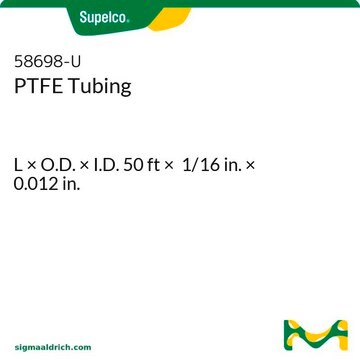71376
Cloruro de sodio
BioUltra, for molecular biology, ≥99.5% (AT)
Sinónimos:
Halita, sal de roca, NaCl
About This Item
Productos recomendados
grado
for molecular biology
Nivel de calidad
presión de vapor
1.33 (1.00 mmHg) at 865 °C hPa
Línea del producto
BioUltra
Análisis
≥99.5% (AT)
formulario
solid
disponibilidad
not available in (Sales restrictions may apply)
técnicas
mass spectrometry (MS): suitable
western blot: suitable
impurezas
DNases, none detected
RNases, none detected
insoluble matter, passes filter test
phosphatases, none detected
proteases, none detected
≤0.001% total nitrogen (N)
pH
5.0-8.0 (25 °C, 1 M in H2O)
mp
801 °C (lit.)
solubilidad
H2O: 1 M at 20 °C, clear, colorless
densidad
2.16 g/cm3 at 25 °C (77 °F)
trazas de anión
bromide (Br-): ≤50 mg/kg
hexacyanoferrate(II) ([Fe(CN)6]4-): ≤1 mg/kg
iodide (I-): ≤10 mg/kg
phosphate (PO43-): ≤5 mg/kg
sulfate (SO42-): ≤200 mg/kg
trazas de catión
Al: ≤5 mg/kg
As: ≤0.1 mg/kg
Ba: ≤5 mg/kg
Bi: ≤5 mg/kg
Ca: ≤10 mg/kg
Cd: ≤5 mg/kg
Co: ≤5 mg/kg
Cr: ≤5 mg/kg
Cu: ≤5 mg/kg
Fe: ≤1 mg/kg
K: ≤50 mg/kg
Li: ≤5 mg/kg
Mg: ≤5 mg/kg
Mn: ≤5 mg/kg
Mo: ≤5 mg/kg
Ni: ≤5 mg/kg
Pb: ≤5 mg/kg
Sr: ≤5 mg/kg
Zn: ≤5 mg/kg
cadena SMILES
[Na+].[Cl-]
λ
1 M in H2O
Absorción UV
λ: 260 nm Amax: ≤0.01
λ: 280 nm Amax: ≤0.01
idoneidad
suitable for component for culture media
suitable for molecular biology
aplicaciones
genomic analysis
InChI
1S/ClH.Na/h1H;/q;+1/p-1
Clave InChI
FAPWRFPIFSIZLT-UHFFFAOYSA-M
¿Está buscando productos similares? Visita Guía de comparación de productos
Descripción general
Aplicación
- as a component of buffer solution to prepare the pH solutions for open-circuit potential and cyclic voltammetry
- in the preparation of Bold’s basal medium (BBM)
- as a component of transcription and annealing buffer
- to maintain osmotic balance and ensure the purity and stability of the isolated extracellular vesicles (EVs)
- as a buffer for the lamination of lateral flow strips in the fabrication of lateral flow devices
Acciones bioquímicas o fisiológicas
Características y beneficios
- Suitable for molecular biology and biochecmial research
- Free from DNase, RNase, NICKase and protease
- Tested to confirm low levels of heavy metal contamination, ensuring suitability for various applications.
- Tested for the presence of Anionic and Cationic traces
Otras notas
producto comparable
Código de clase de almacenamiento
13 - Non Combustible Solids
Clase de riesgo para el agua (WGK)
WGK 1
Punto de inflamabilidad (°F)
Not applicable
Punto de inflamabilidad (°C)
Not applicable
Equipo de protección personal
Eyeshields, Gloves, type N95 (US)
Certificados de análisis (COA)
Busque Certificados de análisis (COA) introduciendo el número de lote del producto. Los números de lote se encuentran en la etiqueta del producto después de las palabras «Lot» o «Batch»
¿Ya tiene este producto?
Encuentre la documentación para los productos que ha comprado recientemente en la Biblioteca de documentos.
Los clientes también vieron
Nuestro equipo de científicos tiene experiencia en todas las áreas de investigación: Ciencias de la vida, Ciencia de los materiales, Síntesis química, Cromatografía, Analítica y muchas otras.
Póngase en contacto con el Servicio técnico



